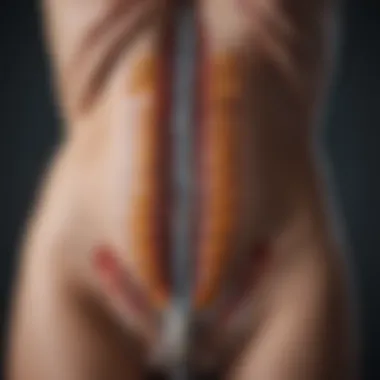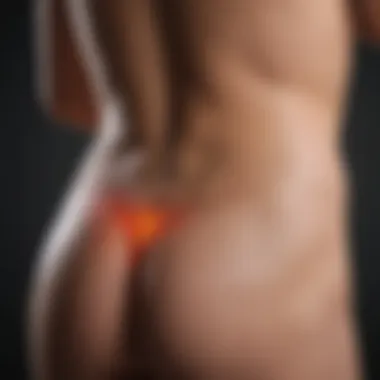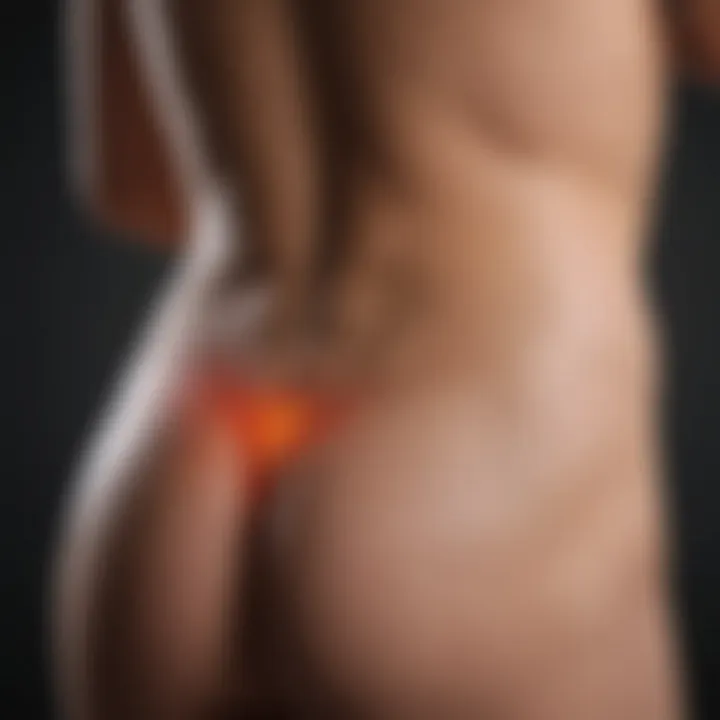Understanding Severe Lower Back Pain and Bladder Control


Intro
Severe lower back pain and loss of bladder control are significant health concerns that can drastically affect one’s quality of life. These symptoms may not appear connected at first glance, but they can arise from similar underlying issues. Understanding this relationship is crucial for effective diagnosis and treatment. In this article, we will explore the complex dynamics that link these two conditions, along with their causes, diagnostic strategies, and treatment options.
Summary of Objectives
The main goal of this article is to provide a clear and detailed understanding of how severe lower back pain can be related to loss of bladder control. This includes examining various potential causes, such as neurological disorders, orthopedic conditions, and other health issues. Readers will gain insights into how these symptoms can emerge together and what that may indicate about a person’s overall health.
Importance of the Research
Research in this area is critical for several reasons:
- Early Intervention: Identifying the link between back pain and bladder control problems can lead to quicker diagnosis and treatment.
- Multidisciplinary Management: Acknowledging the connection may encourage a collaborative approach among healthcare providers.
- Patient Education: Understanding these symptoms can empower patients in their own healthcare journey, prompting them to seek timely medical advice.
By examining these issues through a focused lens, this article aims to enhance the collective knowledge about severe lower back pain and its potential implications on bladder function.
Results and Discussion
Presentation of Findings
The examination of severe lower back pain and bladder control loss reveals several interconnected factors. Conditions like herniated discs, spinal stenosis, or cauda equina syndrome can manifest with both symptoms. Research indicates that nerve impairment due to these conditions can affect bladder function, leading to incontinence or urgency.
Moreover, specific studies highlight how psychological factors and chronic pain conditions can exacerbate both types of symptoms. The impact of stress and emotional well-being can hinder recovery and complicate treatment pathways.
Implications of Results
The findings underscore the need for a precise and thorough approach in treating patients with these symptoms. Treatment may vary widely depending on the underlying cause. Options may include:
- Medication: To manage pain and underlying conditions.
- Physical Therapy: For strengthening and rehabilitation.
- Surgery: In cases where conservative treatments fail.
A comprehensive assessment by a healthcare provider, involving neurologists and orthopedic specialists, can provide the best outcome for patients suffering from these related conditions.
Preface
Understanding the intersection between severe lower back pain and loss of bladder control is vital for many individuals facing these debilitating conditions. The experience of both symptoms can be distressing, significantly affecting a person's quality of life. These symptoms may arise from various medical conditions, leading to a complex web of diagnosis and treatment options. As such, comprehending these interconnections can facilitate prompt intervention and improve patient outcomes.
Importance of the Issue
Severe lower back pain serves as more than just an isolated symptom. It can signal deeper issues related to spinal health, nerve function, and sometimes systemic conditions. Recognizing the potential link between such pain and bladder control loss provides critical insight into underlying medical problems. For instance, an intervertebral disc herniation or spinal stenosis can compress nerve roots associated with bladder function, leading to a constellation of symptoms that merits immediate clinical attention.
Furthermore, loss of bladder control can significantly impact an individual’s social interactions and psychological well-being. Patients suffering from this can face increased anxiety, depression, and a withdrawal from social activities due to fear of accidents or embarrassment. Therefore, understanding the severity and implications of these symptoms not only highlights a medical concern but also places emphasis on their psychological ramifications.
Scope of the Article
This article endeavors to provide a comprehensive examination of severe lower back pain alongside loss of bladder control. It covers various aspects, including defining key symptoms, differential diagnosis, and potential causes that may lead to these concurrent symptoms. By offering detailed analysis on diagnostic approaches and therapeutic interventions, this article aims to equip readers with necessary knowledge to better understand these challenges.
Each section will delve into specific issues pertaining to spinal health and urological functions as well as the relationship between them. The article looks to consolidate information from neurological and orthopedic perspectives to offer well-rounded insights. The focus will also extend to the implications on quality of life and the importance of appropriate management strategies. Ultimately, this piece aims to underline the significance of a multidisciplinary approach in treating patients who present with these intersecting health concerns.
Defining Severe Lower Back Pain
Defining severe lower back pain is crucial for understanding its implications, particularly when it coexists with loss of bladder control. This relationship is often complex, necessitating clarity and precise identification of symptoms. Lower back pain can range from dull, persistent discomfort to sharp, debilitating sensations. Understanding how to define and categorize this pain enables healthcare providers to assess individual cases effectively and tailor appropriate treatment strategies.
A comprehensive definition of severe lower back pain must account for both the intensity of the pain and its impact on daily functions. Patients may encounter significant limitations in mobility or capabilities, influencing their overall quality of life. Effective definition also enhances communication among medical professionals and assists in identifying the underlying causes of these distressing symptoms.
Symptoms and Characteristics
Severe lower back pain presents with various symptoms that can significantly affect individuals. Commonly reported symptoms include:
- Localized Pain: This can manifest as a sharp ache or persistent dull pain, often in the lower region.
- Radiating Pain: Pain may extend down the legs, suggesting potential nerve involvement.
- Muscle Spasms: Involuntary contractions can occur, leading to increased stiffness and discomfort.
- Altered Sensation: Patients may experience tingling or numbness in lower extremities, indicating nerve disruption.
Each symptom may vary in intensity from person to person, contributing to the need for personalized diagnostic approaches. It is essential to understand and observe the characteristics of the pain. For instance, if the pain worsens with certain movements, or if it is accompanied by weakness in the legs, these can be vital indicators for medical evaluations.
Differential Diagnosis
Differential diagnosis is a core part of evaluating severe lower back pain, especially in contexts where bladder control is also compromised. Properly categorizing the pain aids in determining its root causes. Here are some conditions that may mimic or contribute to severe lower back pain:
- Herniated Discs: These may pushing against nerves, leading to both pain and neurological symptoms.
- Spinal Stenosis: Narrowing of spinal canal can result in pressure on nerves, causing significant discomfort.
- Spondylolisthesis: This condition involves vertebrae slipping out of place, resulting in acute pain.
- Kidney Issues: Sometimes, problems with the kidneys can manifest as back pain, highlighting the need for thorough investigations.


A correct diagnosis requires detailed patient history and physical examinations. Factors such as medical history, family history, and daily activities also play a significant role in understanding the nature of the pain, thus guiding the diagnostic process.
Understanding the symptoms and differentiating diagnoses is paramount in addressing spiritual lower back pain. This stage lays the groundwork for more sophisticated evaluations and effective treatment plans.
Understanding Loss of Bladder Control
Loss of bladder control is a significant aspect to consider in the context of severe lower back pain. It can deeply impact a person's daily life, influencing both physical and psychological well-being. In understanding the interplay between these two conditions, one uncovers the root causes and available treatments. The inability to control bladder function is not just a minor inconvenience; it is often a symptom of underlying neurological or orthopedic issues that require comprehensive evaluation and treatment.
When a patient presents with both lower back pain and bladder control issues, the clinical picture becomes complex. These symptoms may indicate nerve compression, spinal cord injuries, or other serious conditions that need immediate attention. Understanding bladder control mechanisms is crucial, as it informs both diagnosis and treatment approaches.
In this article, we will explore the intricacies of bladder control, its mechanisms, and various dysfunction types to better equip those dealing with these symptoms. Examining the relationship between lower back pain and bladder dysfunction aids in forming a holistic view of a patient’s condition. Recognizing that the two are not mutually exclusive helps practitioners in crafting more effective treatment plans.
"Bladder dysfunction can significantly decrease quality of life, making awareness and understanding crucial for timely intervention."
Mechanisms of Bladder Control
The mechanisms involved in bladder control are complex and involve the coordination of various systems within the body, particularly the nervous system. The bladder is a muscular sac that stores urine until it is expelled. Control over bladder function mainly resides within the central nervous system, specifically the spinal cord and brain.
The process of storing and voiding urine relies on signals sent between the bladder wall, the spinal cord, and the brain. Here are the main components involved:
- Detrusor Muscle: This is the muscle lining the bladder that contracts during urination.
- Internal and External Sphincters: These muscles control the opening of the urethra. The internal sphincter is involuntary, while the external sphincter is under voluntary control.
- Nerve Signals: The autonomic nervous system sends signals to the bladder, informing it when to contract and when to relax. Damage to these nerves can lead to loss of control.
Disruptions in this communication often result in various forms of bladder dysfunction, which we will cover in the next section. A clear understanding of these mechanisms assists healthcare providers in recognizing the points of failure in the control system, guiding them toward effective treatment methodologies.
Types of Bladder Dysfunction
Bladder dysfunction can manifest in several forms, which may vary significantly in their causes and treatments. The following types are often seen in conjunction with severe lower back pain:
- Urge Incontinence: This is a sudden and intense urge to urinate, followed by involuntary leakage. It is often associated with overactive bladder syndrome.
- Stress Incontinence: This occurs when physical activity like coughing, sneezing, or exercising puts pressure on the bladder, leading to leakage.
- Overflow Incontinence: Resulting from a consistent feeling of fullness, overflow incontinence occurs when the bladder does not fully empty.
- Functional Incontinence: In this type, cognitive or physical impairments hinder the ability to get to the bathroom in time.
Understanding these dysfunctions is essential for both diagnosis and treatment. Patients need to be informed not only about the nature of their symptoms but also about how these can affect their overall well-being and daily functioning.
The intricate relationship between severe back pain and loss of bladder control necessitates a comprehensive approach to assessment and intervention. Recognizing the signs and symptoms can facilitate timely and appropriate management, ultimately leading to improved patient outcomes.
Potential Causes of Co-occurring Symptoms
The relationship between severe lower back pain and loss of bladder control is intricate and multifaceted. Understanding the potential causes of these co-occurring symptoms can be pivotal for diagnosis and treatment. The aim here is to provide insight into why these symptoms may emerge together, their impact on patient well-being, and the clinical considerations necessary for effective management.
Nerve Compression Disorders
Nerve compression disorders represent one of the most significant contributors to both lower back pain and bladder dysfunction. These conditions occur when surrounding tissues exert pressure on nerves, leading to pain, sensory deficits, and loss of function. Common forms include herniated discs and lumbar stenosis.
In cases of herniated discs, the sensitive nerves near the spine can become compressed. This pressure can lead not only to localized pain but may also disrupt signals critical for bladder control. Patients may report symptoms such as tingling, numbness, and weakness along with the primary complaint of back pain.
Spinal Cord Injuries
Spinal cord injuries are another serious cause of co-occurring lower back pain and bladder issues. Any injury to the spinal cord can disrupt nerve signaling, often leading to a range of symptoms based on the location and severity of the injury.
For instance, injuries at the thoracic and lumbar levels may directly impact bladder function. Damage can result in the inability to exert control over urination, manifesting as severe incontinence. Such cases warrant urgent medical intervention due to the potential for lasting complications, making early diagnosis crucial.
Multiple Sclerosis and Its Implications
Multiple sclerosis is a chronic illness that can lead to significant neurologic impairment. It affects the central nervous system, disrupting communication between the brain and the body. Many patients with multiple sclerosis experience lower back pain, which can stem from muscle spasms, compromised posture, or neurogenic pain.
Moreover, the demyelination of the nerves can impair bladder control, creating a complex situation for those affected. Symptoms could range from frequent urination to complete loss of control.
An understanding of multiple sclerosis in the context of back pain is critical for care providers to design appropriate treatment plans that address both the neurological and musculoskeletal components of the condition.
Diagnostic Approaches
Diagnosing the interplay between severe lower back pain and loss of bladder control represents a critical component in medical evaluations. An accurate diagnosis allows for targeted treatment, addressing both symptoms effectively rather than merely alleviating one at the expense of the other. Understanding the underlying causes of these symptoms can lead to appropriate interventions that improve the patient’s quality of life. The diagnostic approaches often involve a combination of clinical assessments, imaging techniques, and neurophysiological evaluations.
Clinical Examination and History Taking
A thorough clinical examination is foundational in diagnosing lower back pain with accompanying bladder control issues. Physicians often start by conducting a detailed history taking. This involves gathering information about the patient's symptoms, their onset, duration, and any associated conditions. Key questions center around:
- Nature of the pain: Is it sharp, dull, or radiating?
- Timing of symptoms: Is there a correlation with specific activities or times of day?
- Bladder issues: Are there patterns of urgency, frequency, or incontinence?
During the physical examination, doctors typically assess range of motion, tenderness, and any neurological deficits. Tests like straight-leg raises may also reveal certain nerve irritations. This not only clarifies the severity of pain but also determines if there are any defining factors contributing to the symptoms.
Imaging Techniques
Imaging plays a crucial role in diagnostic processes, especially in musculoskeletal conditions. Techniques such as MRI and CT scans provide a detailed view of the spinal structures, nerve roots, and surrounding tissues.
- Magnetic Resonance Imaging (MRI): Commonly used to evaluate soft tissues, MRI can highlight herniated discs or other spinal anomalies that may compress surrounding nerves, thus contributing to both back pain and bladder dysfunction.
- Computed Tomography (CT) Scan: CT scans offer detailed cross-sectional images. They help in detecting bone fractures or degenerative changes that could impinge on neurological functions.


Using these imaging methods increases the accuracy of diagnosis, aiding in identifying structural abnormalities that may necessitate intervention.
Neurophysiological Assessments
Neurophysiological assessments are another integral part of the diagnostic process. These tests measure the electrical activity of nerves and muscles, offering insight into the functional status of various neurological components.
Tests like electromyography (EMG) can evaluate the electrical activity of muscles, determining if nerve root compression contributes to dysfunction. Similarly, urodynamic studies may assess bladder function, revealing how well the bladder fills and empties, which is essential when bladder control issues arise.
Ultimately, these assessments can discern whether symptoms stem from direct nerve damage or other complex neurological pathways.
It's critical to adopt a tailored diagnostic strategy, combining multiple evaluation methods to achieve a comprehensive understanding of both severe lower back pain and loss of bladder control.
This multifaceted approach enables healthcare professionals to design effective treatment pathways, fostering a system of care that addresses both immediate symptoms and long-term management.
Impact on Quality of Life
Severe lower back pain and loss of bladder control can significantly affect a person's quality of life. The interrelation between these conditions is complex, yet understanding this impact is crucial for effective management and treatment. Quality of life encompasses physical, emotional, and social aspects. When individuals face these debilitating symptoms, their ability to engage in daily activities may drastically reduce. Patients often experience limitations in mobility and functionality, which can lead to a cycle of further health complications.
Physical limitations are often the most noticeable. Many people may find it hard to perform basic tasks, such as bending, lifting, or even standing for extended periods. During acute episodes, the constraints can become overwhelming. This can lead to difficulties in professional environments, ultimately impacting a person's career and personal achievements. The prolonged absence from work or social gatherings can engender feelings of isolation and frustration.
Moreover, chronic pain can lead to emotional distress. The persistent nature of severe lower back pain and bladder dysfunction might result in anxiety and depression. Patients may become reluctant to engage in social interactions due to fear of bladder accidents or the unpredictability of pain flare-ups. These psychosocial factors can perpetuate a sense of helplessness.
It is pivotal to recognize that addressing the impact on quality of life is not merely about managing physical symptoms. Professionals should approach treatment holistically. Evaluating how these conditions affect various life domains can lead to tailored interventions.
"Understanding the psychological and social ramifications of chronic conditions is essential for a comprehensive treatment plan."
Physical Limitations
Physical limitations often manifest in various ways when someone suffers from severe lower back pain combined with bladder control issues. These conditions can limit mobility, making even routine tasks demanding. For example:
- Difficulty in mobility: Many individuals experience challenges in moving freely. Activities such as walking, climbing stairs, or even sitting for long durations may become exhausting.
- Impact on daily tasks: Simple chores, from grocery shopping to cleaning, can turn daunting. The pain may compel individuals to modify their routines or avoid certain tasks altogether, which can lead to a lack of independence.
- Avoidance behaviors: People may start to avoid physical activities they once enjoyed. This can lead to further physical decline and exacerbate feelings of frustration.
Acknowledging these physical limitations is vital. They not only impact day-to-day living but can also affect a person’s self-esteem.
Psychosocial Factors
The psychosocial implications of severe lower back pain and loss of bladder control are often underestimated. Beyond the physical burden, there are significant psychological effects that must be addressed. Key considerations include:
- Mental health challenges: Chronic pain can lead to a range of mental health issues, including anxiety and depression. The constant strain of managing both pain and bladder issues can feel overwhelming.
- Social isolation: The fear of experiencing symptoms publicly can lead individuals to withdraw from social engagements. This isolation can intensify feelings of loneliness and may further exacerbate mental health struggles.
- Impact on relationships: Persistent pain and its associated challenges can strain relationships with family and friends. Misunderstanding and lack of support from loved ones can create rifts, leading to additional stress.
Addressing these psychosocial factors is essential for comprehensive treatment. Engaging mental health professionals and support groups can provide the necessary tools for patients to cope with their conditions more effectively.
Therapeutic Interventions
Therapeutic interventions play a critical role in the management of severe lower back pain and accompanying loss of bladder control. These interventions aim not only to alleviate pain but also to restore function and improve the overall quality of life for patients. It is essential to adopt a holistic approach that considers both the physical and psychosocial aspects of recovery.
Physical Therapy Approaches
Physical therapy is often the first line of treatment for patients experiencing severe lower back pain. It encompasses a variety of strategies aimed at improving mobility, strength, and function. Common techniques include:
- Exercise Therapy: Targeted exercises designed to strengthen the core, improve flexibility, and enhance overall stability can significantly reduce the incidence of pain.
- Manual Therapy: Hands-on techniques, including manipulation and mobilization, can help alleviate muscle tension and realign spinal structures.
- Education: Educating patients about posture, body mechanics, and ergonomics can empower them to manage their conditions more effectively.
Physical therapy not only addresses the immediate symptoms but also focuses on preventing future recurrences of pain. By promoting muscular balance and posture awareness, it contributes to long-term health.
Medications and Pain Management
Effective pain management is vital for individuals suffering from severe lower back pain. Medications may be prescribed to control pain and maintain functionality. Common medications include:
- Nonsteroidal Anti-inflammatory Drugs (NSAIDs): These reduce inflammation and alleviate pain. Examples include ibuprofen and naproxen.
- Corticosteroids: Used for their potent anti-inflammatory effects, these may be administered orally or via injection depending on severity.
- Muscle Relaxants: These are beneficial for alleviating muscle spasms associated with lower back pain.
- Antidepressants and Anticonvulsants: Sometimes prescribed for chronic pain, these can help in altering pain perception.
Balancing the use of medications with non-pharmacological approaches, such as physical therapy, often leads to more effective management.
Surgical Options
In cases where conservative treatments fail to provide relief, surgical intervention may be warranted. The decision to proceed with surgery must be carefully considered and discussed with a healthcare professional. Common surgical options include:
- Discectomy: This procedure involves the removal of herniated disc material that presses on nerves. It can offer relief from pain and restore bladder function.
- Laminectomy: Aimed at decompressing the spinal cord or nerve roots, laminectomy involves removing part of the vertebra.
- Spinal Fusion: This procedure stabilizes the spine by joining two or more vertebrae, which can alleviate pain related to instability.


Each surgical option carries its own risks and benefits, making the discussion of eligibility and potential outcomes essential prior to making any decisions.
"Comprehensive evaluation and tailored therapeutic interventions are crucial for optimizing outcomes in patients with severe lower back pain and bladder control issues."
Prevention Strategies
Prevention strategies for severe lower back pain and loss of bladder control are essential because they can help minimize risks and improve overall well-being. Focusing on how to prevent these conditions can lead to significant long-term benefits for individuals. By addressing ergonomic factors and lifestyle changes, one can alleviate symptoms and reduce the likelihood of severe complications.
Ergonomic Improvements
Ergonomic improvements are critical in preventing lower back pain, especially for those who work in sedentary jobs or engage in repetitive tasks. Proper ergonomics can significantly reduce strain on the back and improve posture. Some effective strategies include:
- Adjusting your workstation: Ensuring that your chair, desk, and computer are at appropriate heights can help maintain good posture. Your feet should rest flat on the ground, and your arms should be at a comfortable angle.
- Using ergonomic furniture: Chairs designed with lumbar support can promote spinal alignment. Standing desks may also be beneficial, allowing for better posture and movement.
- Practicing good lifting techniques: When lifting heavy objects, it is important to bend at the knees, not at the waist. This technique can significantly decrease the strain on the back.
Implementing these ergonomic principles can greatly reduce the frequency and intensity of back pain episodes.
Lifestyle Modifications
Lifestyle modifications play a crucial role in preventing severe lower back pain and related bladder control issues. Simple changes in daily habits can yield significant results. Consider the following adjustments:
- Regular exercise: Engaging in physical activities such as stretching, yoga, or swimming can strengthen back muscles and improve flexibility. Strong muscles around the spine provide better support and help prevent injuries.
- Maintaining a healthy weight: Excess weight can put added stress on the spine, increasing the risk of pain and complications. A balanced diet combined with regular activity can help maintain an optimal weight.
- Avoiding prolonged sitting or standing: Taking breaks to stand, stretch, or walk can mitigate stiffness and reduce pressure on the lower back. This strategy is particularly important during long hours at a desk or in front of a screen.
In summary, by prioritizing ergonomic improvements and modifying lifestyle choices, individuals can effectively work towards preventing severe lower back pain and loss of bladder control. This proactive approach lays a foundation for better health and quality of life.
The Role of Multidisciplinary Teams
In the context of severe lower back pain and loss of bladder control, the role of multidisciplinary teams is critical. These teams are composed of various health professionals, including neurologists, orthopedic specialists, physical therapists, pain management experts, and occupational therapists. Each member brings unique expertise, facilitating a more thorough approach to patient care. This collaboration fosters a comprehensive understanding of complex conditions, leading to better diagnosis and tailored treatment plans.
Several benefits arise from multidisciplinary teamwork:
- Holistic Assessment: Health professionals evaluate all aspects of a patient's condition. A team can identify both back pain sources and bladder dysfunction.
- Individualized Treatment Plans: Collaboration enables the creation of personalized treatment strategies. Each professional contributes insights based on their specialization.
- Efficient Resource Utilization: Teams optimize resources, directing patients to the most appropriate interventions quickly and seamlessly.
This collaborative model is especially important for patients facing severe conditions. The comprehensive approach reduces the likelihood of fragmented care, ensuring that all symptoms are addressed.
"Multidisciplinary teams bring together diverse skills and perspectives, leading to improved outcomes in complex medical conditions."
Collaborative Care Models
Collaborative care models represent a shift from traditional treatments. In these models, professionals work in real-time, sharing information about patient progress. Mechanisms, such as joint meetings or digital communication, ensure everyone stays informed.
The benefits of collaborative care are significant:
- Enhanced Communication: Regular discussions among team members lead to more informed decision-making.
- Patient-Centered Care: Focus shifts to the patient's overall well-being. Teams prioritize long-term outcomes over isolated symptoms.
- Shared Responsibilities: Workload is distributed among team members. This can reduce individual burnout and promote better care quality.
Each team member is integral to the patient’s journey. From initial assessments to rehabilitation, collaborative models support comprehensive care.
Referral Processes
Effective referral processes are vital in managing severe lower back pain with bladder control issues. When a patient presents symptoms, timely referral to the appropriate specialist can make a significant difference.
A clear referral strategy ensures:
- Swift Access to Specialists: Prompt referrals prevent delays in diagnosis and treatment.
- Continuity of Care: Maintaining clear communication among all involved providers helps track progress and adjust treatment as needed.
- Comprehensive Documentation: Proper documentation of referral processes informs all parties involved, supporting a thorough understanding of the patient’s condition.
Referrals must be handled with careful consideration. Health professionals must assess when it is necessary to involve other specialties. In doing so, they create a robust support network for patients, enhancing overall management strategies.
Finale
The conclusion of this article marks a critical juncture in comprehending the interplay between severe lower back pain and bladder control issues. This complex relationship necessitates a thoughtful examination of both symptoms and underlying conditions, providing valuable insights for effective management and rehabilitation.
Understanding the findings presented reveals the intricate connections that exist between neurologic and orthopedic aspects of these conditions. It emphasizes the importance of recognizing that addressing one symptom may involve uncovering another. Hence, this prompts clinicians to adopt a holistic view when approaching patient care.
Summary of Findings
The examination of severe lower back pain alongside loss of bladder control has unveiled several key elements:
- Interconnectedness of Symptoms: The relationship between lower back pain and bladder dysfunction often stems from similar underlying issues, such as nerve compression or spinal cord injuries.
- Diagnostic Necessities: A robust diagnostic process, integrating clinical examination, imaging techniques, and neurophysiological assessments, is paramount in identifying the root causes of these symptoms.
- Impact on Quality of Life: The co-occurrence of these conditions significantly diminishes the quality of life of affected individuals, manifesting in both physical limitations and psychosocial challenges.
- Therapeutic Interventions: Comprehensive treatment plans must encompass an array of strategies, including physical therapy, medication, and possibly surgical options, tailored to patient-specific needs.
Future Directions in Research
Future research efforts should focus on several critical areas to advance our understanding of severe lower back pain and bladder dysfunction:
- Longitudinal Studies: Conducting long-term studies could reveal associative patterns and causative factors over time, enhancing predictive capacities.
- Multidisciplinary Approaches: Further exploration into the effectiveness of multidisciplinary care models is essential to improving patient outcomes.
- Emerging Technologies: Investigating the role of advanced imaging techniques and innovative therapies in diagnosing and treating related disorders would benefit future treatment approaches.
- Patient-Centric Research: Surveying patient experiences may provide insights into the most pressing concerns and effective management strategies from their perspectives, contributing to more targeted and effective healthcare solutions.
In closing, the topical considerations presented herein necessitate ongoing dialogue and inquiry within medical communities as we advance toward improved management strategies for these interrelated health challenges.















